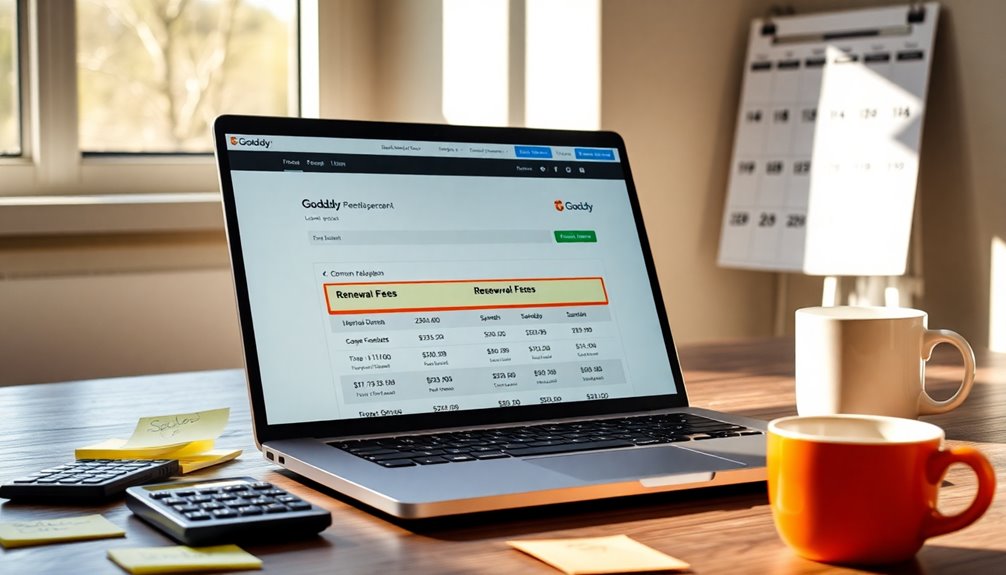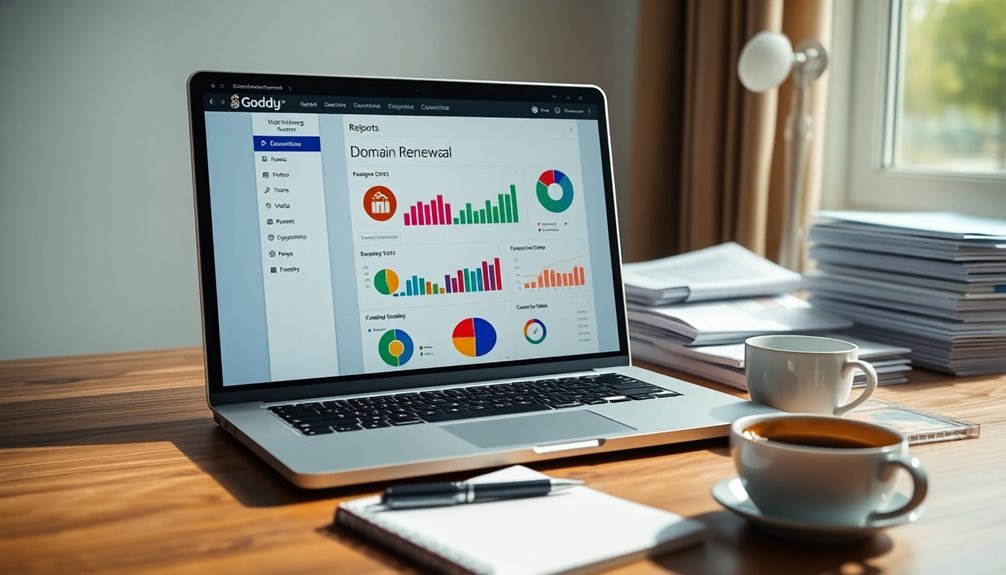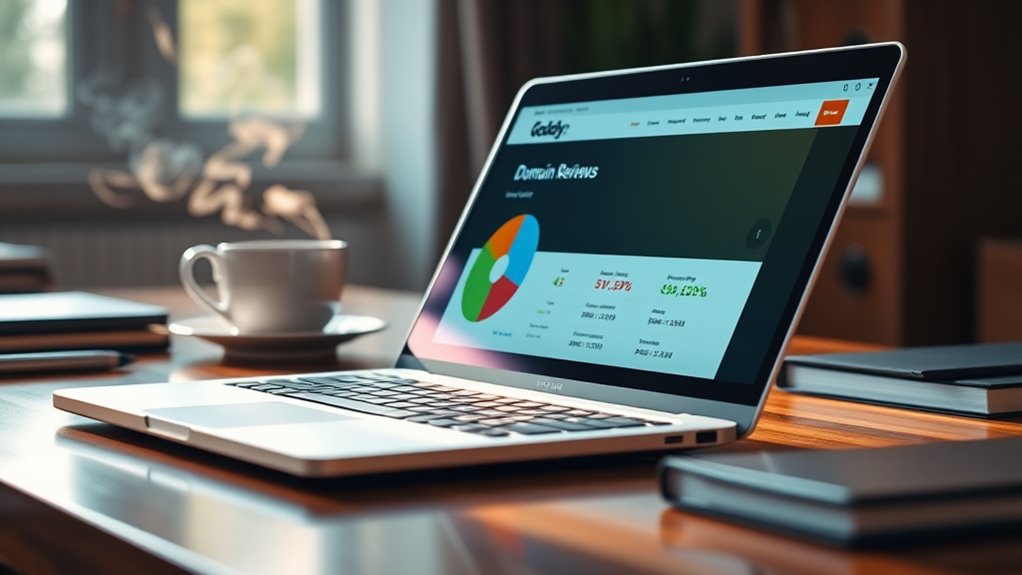Understanding GoDaddy's domain renewal fees is vital for maintaining your online presence. Renewal prices vary by domain extension, ranging from $14.99 to $34.99 annually. While common domains like .com and .org typically cost between $14.99 and $20.99, fees may increase after the first year, sometimes by 25% or more. It's important to monitor potential changes in renewal prices and enable auto-renewal for valuable domains to prevent lapses. Setting reminders before expiration dates can save you unexpected expenses. You'll find even more insights as you explore how to manage your domain effectively.
Domain Renewal Process
When it comes to renewing your domain at GoDaddy, you'll typically pay a one-year registration fee, which ranges from $14.99 to $17.99 for common extensions like .com, .org, and .net.
The domain renewal process is straightforward, but you need to pay attention to your expiration date to avoid any service interruptions. If you let your domain expire, you might face redemption fees, which can add unnecessary costs. Regularly reviewing your backup logs ensures the reliability of your website in case of any disruptions during the renewal process. Implementing a backup frequency that matches your site's activity can also help mitigate risks during this time.
To streamline your domain management, consider enabling auto renew. This feature automatically renews your domain before the expiration date, ensuring you don't accidentally lose your online presence.
Remember, the renewal price you see doesn't include optional services like Domain Protection or Premium DNS, which might incur additional charges.
You can customize your domain list view in the GoDaddy Domain Portfolio to include the Renewal Price column. This helps you track upcoming renewals and manage your expenses effectively.
If you miss the renewal window, you still have up to 72 days to renew your domain before it's removed from your account. Staying proactive in the renewal process will save you time and money in the long run. Additionally, implementing regular backups can safeguard your website data against unexpected issues during the renewal process.
Viewing Renewal Prices
To view renewal prices for your domains, simply sign in to your GoDaddy Domain Portfolio. Once you're in, you'll find detailed renewal pricing information for each of your domains.
To make it easier to track, customize your domain list view by selecting the Columns icon and checking the box for Renewal Price. This way, you can see the renewal prices at a glance. Including relevant keywords in your domain name can also boost rankings and attract targeted traffic. A memorable domain name significantly enhances user retention and engagement.
Keep in mind that the renewal price reflects a one-year registration and doesn't include additional services like Domain Protection or Premium DNS. It's important to monitor renewal prices regularly, as they can change over time, and you might want to adjust your strategy accordingly.
If you prefer, you can turn off auto-renewal after reviewing these prices.
Additionally, don't forget to check your renewal dates often. This practice helps you avoid lapses in services like email or website hosting, which aren't automatically renewed with your GoDaddy Domain registration. Remember, having a domain name length under 15 characters can improve user retention and reduce typos, making it easier for visitors to return to your site.
Additional Considerations

As you navigate the domain renewal process, there are several additional factors to keep in mind. First, remember that renewal prices for your domain don't automatically include associated services like email hosting or website maintenance. You'll need to renew those separately to avoid interruptions.
Here are some key points to take into account:
- Varying Renewal Prices: Different domain extensions have different renewal rates. For example, .com domains may cost around $17.99 annually, while others could be higher.
- Potential Increases: Be aware that renewal fees might rise after the first year, with hikes of up to 25% or more, impacting your total cost. Additionally, investing in a reliable hosting provider can help mitigate future costs associated with downtime or site issues.
- Monitor Renewal Dates: Keeping an eye on renewal dates is vital. If you miss them, your domain could enter auction phases.
- Customer Support: Don't hesitate to reach out to customer support if you have questions about renewal prices or processes. They can guide you through any uncertainties.
Additionally, consider the importance of quality hosting as it can significantly affect your site's performance and security.
Security Measures
Robust security measures are essential for protecting your GoDaddy account and domain. One of the most effective ways to enhance your security is by implementing 2-step verification. This feature requires a second form of identification during login attempts, making it much harder for unauthorized access to occur. Additionally, activating two-factor authentication can further strengthen your login security.
Additionally, enabling Domain Protection is important. It helps prevent accidental expiration of your domain by restricting unauthorized changes to your domain settings.
Regularly updating your security settings and monitoring your account activity for any unusual transactions is also critical. This proactive approach can help you identify potential issues before they escalate. Implementing strong security practices, such as using strong, unique passwords, can significantly reduce the risk of unauthorized access to your account.
GoDaddy offers various protection options, including additional security features designed to safeguard against unauthorized actions and potential domain theft. Utilizing strong, unique passwords is another key step in reducing the risk of unauthorized access to your account.
Expiration Timeline

After securing your GoDaddy account, understanding the expiration timeline of your domain is vital to maintaining ownership.
Knowing how domain renewals work can save you from losing your valuable web address. Here's what you need to keep in mind:
- Your domain attempts to auto-renew on the expiration date.
- You can manually renew your domain at the standard price for one day after expiration.
- If the first auto-renew fails, a second attempt occurs five days post-expiration.
- After 19 days, your domain enters an inactive status and can still be manually renewed with a redemption fee.
It's important to act quickly if you miss the auto-renewal.
The price of your domain can increase markedly after the initial grace period, especially if you need to pay redemption fees. GoDaddy's competitive pricing helps you avoid these costs if you stay on top of renewals.
Remember, if you let your domain sit too long, you may lose it to other domain registrars.
Keep track of these timelines to secure your domain and avoid unexpected fees!
Auction Phases
Once a domain reaches the auction phase, you have a vital opportunity to reclaim it. This phase begins 26 days after expiration, and during this time, you can still manually renew the domain at the standard price plus a redemption fee.
If you don't place any bids within the first 30 days of the auction phase, the domain remains in your account, allowing for that manual renewal option.
As you approach the final closeout auction, which starts 36 days after expiration, keep in mind that you can still renew the domain manually unless someone else has initiated a pending purchase.
After 41 days, the closeout auction ends, and you still have the chance to renew the domain at the standard price plus the redemption fee.
However, if you don't act within 72 days post-expiration, the domain will be removed from your account and won't be available for renewal.
At that point, it may become available for future registration after being released by the registry. It's essential to stay proactive during the auction phase to protect your domain from slipping away.
Related Steps

To keep your domain active, consider enabling auto-renewal, which can save you from last-minute hassles.
If you do miss the renewal date, knowing the manual renewal process is essential to avoid losing your domain.
Staying on top of expiration dates and renewal fees will help you manage your domain effectively.
Auto-Renewal Benefits
Enabling auto-renewal for your GoDaddy domain can save you from the hassle of missed renewals and potential service interruptions. By allowing GoDaddy to automatically renew your domain on the expiration date, you guarantee a seamless continuation of your online presence without any manual effort.
Here are some key benefits of auto-renewal:
- Prevent lapses in service: Your domain registration renews automatically, keeping your website active.
- Second chance at renewal: If the first auto-renewal attempt fails, GoDaddy tries again five days later.
- Control over budgeting: You can turn off auto-renewal anytime after considering the renewal prices.
- Reduce stress: Monitoring your account activity becomes easier, helping you avoid redemption fees and other complications.
With auto-renewal, you can focus on growing your business rather than worrying about domain renewal deadlines.
It streamlines the entire process, giving you peace of mind that your domain will remain yours, assuring your online presence stays intact.
Embrace the benefits of auto-renewal and take control of your domain management today!
Manual Renewal Process
How do you guarantee your GoDaddy domain stays active without auto-renewal? The key is to understand the manual renewal process.
First, sign in to your GoDaddy account and head to the Domain Portfolio section. Here, you can view all your domains and their renewal options. Renewal prices usually reflect a one-year registration fee, but keep in mind that any add-ons, like Domain Protection or Premium DNS services, aren't included.
You can manually renew your domain for up to 41 days after expiration at standard prices. However, it's essential to act before the 26-day mark to avoid your domain being placed on hold or entering the auction phase.
Once your domain enters auction, you can still opt for manual renewal, but be prepared to pay both the standard renewal price and any applicable redemption fees.
To stay ahead, monitor your renewal dates closely. By taking these steps, you can effectively manage your domain renewal without relying on auto-renewal, ensuring your GoDaddy domain remains active and protected from unexpected expiration issues.
Monitoring Expiration Dates
Keeping track of your domain's expiration dates is vital for maintaining ownership and preventing service interruptions. Domains can enter various stages of expiration just days after they lapse, so regular monitoring is necessary.
Here are some steps to help you effectively manage your domain renewal:
- Set reminders well in advance of your expiration dates to evaluate your renewal needs.
- Utilize GoDaddy's account features to review your domain portfolio, sorting by expiration date for urgency.
- Consider enabling auto-renewal for valuable domains. This feature helps prevent accidental lapses and maintains continuous ownership.
- Be aware of potential renewal fees. If you miss the renewal deadline, you might face additional charges, such as redemption fees after a grace period.
Pricing Overview
When it comes to renewing your domain with GoDaddy, you'll find that standard renewal prices vary based on the domain extension. For a .com domain, you can expect renewal prices typically between $14.99 and $17.99 per year, with the exact fee being $17.99.
Other extensions like .org and .net have higher rates, sitting at $20.99 and $19.99, respectively. If you're considering a .co domain, be prepared for a steeper price, around $34.99 annually.
Additionally, GoDaddy offers several extra services that can increase your overall renewal fees. Features like Domain Protection and Premium DNS aren't included in the standard renewal costs, so it's essential to account for these when budgeting.
To keep track of renewal prices, you can customize your domain portfolio view by adding the Renewal Price column in your GoDaddy account.
Just remember that the renewal fees you pay for your domain registration don't automatically cover associated services like email hosting or website renewal, which may come with separate charges. Being aware of these details will help you manage your domain renewal costs effectively.
Value Assessment

Evaluating the value of your domains is vital to managing renewal costs effectively. GoDaddy's renewal fees can be higher than some competitors, so you need to determine which domains are worth keeping. By evaluating domain value, you can avoid unnecessary renewal fees and streamline your portfolio.
Here are some key points to contemplate:
- Identify premium domains: Focus on domains that have high potential value or brand recognition.
- Use valuation tools: Tools like Estibot can help you gauge the worth of your domains accurately.
- Early renewals: Renewing your valuable domains ahead of price increases can save you money in the long run.
- Streamline your portfolio: Aim to narrow down your domains to around 100 top choices to enhance management and focus on high-value assets.
With approximately 70 domains potentially being dropped from your renewal list, it's vital to evaluate which domain extensions are worth the investment.
Conclusion
In conclusion, maneuvering through GoDaddy's domain renewal fees doesn't have to be an intimidating task. By staying informed about the renewal process, expiration timelines, and pricing, you can keep your digital presence secure and thriving. Think of it like tending a garden; regular care guarantees your online identity blooms instead of wilting. So, keep an eye on those renewal dates and make informed decisions to avoid any surprises down the road!



